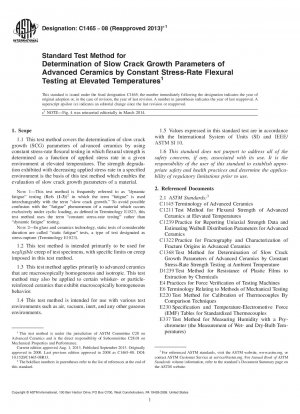ASTM C1465-08(2013)e1
Standard Test Method for Determination of Slow Crack Growth Parameters of Advanced Ceramics by Constant Stress-Rate Flexural Testing at Elevated Temperatures
- Standard No.
- ASTM C1465-08(2013)e1
- Release Date
- 2008
- Published By
- American Society for Testing and Materials (ASTM)
- Status
- Replace By
- ASTM C1465-08(2019)
- Latest
- ASTM C1465-08(2019)
- Scope
4.1 For many structural ceramic components in service, their use is often limited by lifetimes that are controlled by a process of slow crack growth. This test method provides the empirical parameters for appraising the relative slow crack growth susceptibility of ceramic materials under specified environments at elevated temperatures. This test method is similar to Test Method C1368 with the exception that provisions for testing at elevated temperatures are given. Furthermore, this test method may establish the influences of processing variables and composition on slow crack growth as well as on strength behavior of newly developed or existing materials, thus allowing tailoring and optimizing material processing for further modification. In summary, this test method may be used for material development, quality control, characterization, and limited design data generation purposes.
Note 3—Data generated by this test method do not necessarily correspond to crack velocities that may be encountered in service conditions. The use of data generated by this test method for design purposes may entail considerable extrapolation and loss of accuracy.4.2 In this test method, the flexural stress computation is based on simple beam theory, with the assumptions that the material is isotropic and homogeneous, the moduli of elasticity in tension and compression are identical, and the material is linearly elastic. The average grain size should be no greater than one fiftieth (1/50) of the beam thickness.
4.3 In this test method, the test specimen sizes and test fixtures were chosen in accordance with Test Method C1211, which provides a balance between practical configurations and resulting errors, as discussed in Refs (5, 6). Only the four-point test configuration is used in this test method.
4.4 In this test method, the slow crack growth parameters (n and D) are determined based on the mathematical relationship between flexural strength and applied stress rate, log σf = [1/(n + 1)] log σ˙ + log D, together with the measured experimental data. The basic underlying assumption on the derivation of this relationship is that slow crack growth is governed by an empirical power-law crack velocity, v = A[KI /KIC]n (see Appendix X1).
Note 4—There are various other forms of crack velocity laws which are usually more complex or less convenient mathematically, or both, but may be physically more realistic (7) . The mathematical analysis in this test method does not cover such alternative crack velocity formulations......ASTM C1465-08(2013)e1 Referenced Document
- ASTM C1145 Standard Terminology of Advanced Ceramics
- ASTM C1211 Standard Test Method for Flexural Strength of Advanced Ceramics at Elevated Temperatures
- ASTM C1239 Standard Practice for Reporting Uniaxial Strength Data and Estimating Weibull Distribution Parameters for Advanced Ceramics
- ASTM C1322 Standard Practice for Fractography and Characterization of Fracture Origins in Advanced Ceramics
- ASTM C1368 Standard Test Method for Determination of Slow Crack Growth Parameters of Advanced Ceramics by Constant Stress Rate Strength Testing at Ambient Temperature
- ASTM D1239 Standard Test Method for Resistance of Plastic Films to Extraction by Chemicals
- ASTM E1150 Definitions of Terms Relating to Fatigue
- ASTM E1823 Standard Terminology Relating to Fatigue and Fracture Testing
- ASTM E220 Standard Test Method for Calibration of Thermocouples By Comparison Techniques
- ASTM E230 Standard Specification and Temperature-Electromotive Force (EMF) Tables for Standardized Thermocouples
- ASTM E337 Standard Test Method for Measuring Humidity with a Psychrometer (the Measurement of Wet- and Dry-Bulb Temperatures)
- ASTM E4 Standard Practices for Force Verification of Testing Machines
- ASTM E6 Standard Terminology Relating to Methods of Mechanical Testing
- ASTM E616
- IEEE/ASTM SI 10 American National Standard for Metric Practice
ASTM C1465-08(2013)e1 history
- 2019 ASTM C1465-08(2019) Standard Test Method for Determination of Slow Crack Growth Parameters of Advanced Ceramics by Constant Stress-Rate Flexural Testing at Elevated Temperatures
- 2008 ASTM C1465-08(2013)e1 Standard Test Method for Determination of Slow Crack Growth Parameters of Advanced Ceramics by Constant Stress-Rate Flexural Testing at Elevated Temperatures
- 2008 ASTM C1465-08(2013) Standard Test Method for Determination of Slow Crack Growth Parameters of Advanced Ceramics by Constant Stress-Rate Flexural Testing at Elevated Temperatures
- 2008 ASTM C1465-08 Standard Test Method for Determination of Slow Crack Growth Parameters of Advanced Ceramics by Constant Stress-Rate Flexural Testing at Elevated Temperatures
- 2000 ASTM C1465-00(2006) Standard Test Method for Determination of Slow Crack Growth Parameters of Advanced Ceramics by Constant Stress-Rate Flexural Testing at Elevated Temperatures
- 2000 ASTM C1465-00 Standard Test Method for Determination of Slow Crack Growth Parameters of Advanced Ceramics by Constant Stress-Rate Flexural Testing at Elevated Temperatures

Copyright ©2024 All Rights Reserved